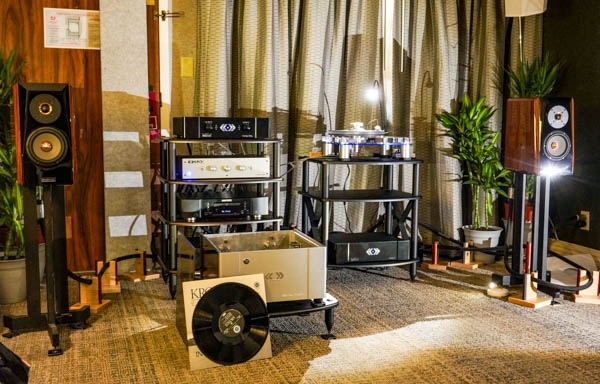| Columns Retired Columns & Blogs |
Any thoughts on how these compare to the earlier Pulsars?

I've used the LKV Research PWR+ Amplifier as part of my reference rig for some time, so it was great to meet LKV’s Bill Hutchins in the flesh at CAF. Connecting with the designer behind a component is always a treat and helps humanize the process of technology-mediated listening.
Hutchins debuted two products at CAF: the LKV Research VNL Phono Preamplifier (price TBD) and the LKV Research PWR 3 power amplifier ($3550). Also in the system were LKV Research's Line One Control Preamplifier ($3500) and PWR+ Class power amplifier ($10,000). The turntable was a world premiere: the Basis Audio’s Bravo Turntable with the Vector Tonearm ($9750); mounted to that 'table was an Audio Technica AT-ART100 Direct Power Stereo MC cartridge ($5000). Two more world premieres: Finley Audio Cirrus speaker cable ($1785–$6786/pair depending on length), and Les Davis Audio Entropic Vibration Control Blocks ($43.56 for a box of four). Rounding out the system: various Finley Audio interconnects and power cables, Les Davis Audio 3D2 Vibration Control Wafers ($6.54/box eight), and—most important—the Joseph Audio Pulsar2 Graphene standmount speakers ($8999/pair).
Hutchins wrote in a press release, about the VNL Phono Preamplifier, “I spent several years reexamining all elements of the phono stage—all circuits, components, and materials—to make it as perfect as possible.”
The LKV Research PWR 3 power amplifier was designed as “little brother” to the LKV Research PWR+, at a “significantly lower price," the press release said. Like the PWR+, it combines Purifi class-D modules with class-A input/voltage gain circuitry and a linear power supply. The PRW 3 delivers 175Wpc into 8 ohms or 350Wpc into 4 and 2 ohms.
Playing Cassandra Wilson’s “Fragile” from her 2003 release, Glamoured (excellent music!), the LKV Research rig rendered her dark voice like rich honey; the system’s sound was precisely, sweetly focused. After hearing so many big systems in large rooms, there was a rightness and familiarity to the Basis/LKV Research/Joseph Audio setup. Music was rendered precisely but not analytically, rich but also clear, and there was drive, punch, and considerable jump to the music.

Any thoughts on how these compare to the earlier Pulsars?